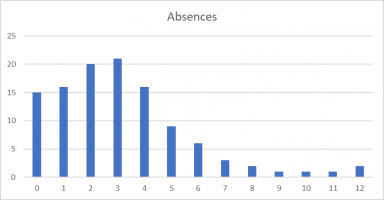Little_Louis
New member
- Joined
- Mar 26, 2022
- Messages
- 15
Hello this is my first post - thank you for your help in advance. I recently completed an online test. This was one of the questions and it baffled me. I have attempted to recreate the question in excel. Please can you help.
The Test Problem
113 students are enrolled on a course of 24 lectures:

x axis = absences, y axis = count
How many of the following can be deduced just from the data in the chart
I then quickly calculated what I thought was the mean given the graph. I got a mean of 3.14 using my own figures as per my table below.
I then looked at the options 1 to 4 and thought 'I don't think any of those are correct'. However the answer must be a number between 1 and 4 correct options.
The Test Problem
113 students are enrolled on a course of 24 lectures:
- Fifteen students attended all lectures
- 98 were absent for between 1 and 12 of the lectures

x axis = absences, y axis = count
How many of the following can be deduced just from the data in the chart
- The mean number of absences per student was 6
- At least half the lectures did not have full attendance
- The most frequent number of students attending a lecture was 91
- One lecture was attended by only 15 students
I then quickly calculated what I thought was the mean given the graph. I got a mean of 3.14 using my own figures as per my table below.
| Absence | Frequency |
| 0 | 15 |
| 1 | 16 |
| 2 | 20 |
| 3 | 21 |
| 4 | 16 |
| 5 | 9 |
| 6 | 6 |
| 7 | 3 |
| 8 | 2 |
| 9 | 1 |
| 10 | 1 |
| 11 | 1 |
| 12 | 2 |
I then looked at the options 1 to 4 and thought 'I don't think any of those are correct'. However the answer must be a number between 1 and 4 correct options.
